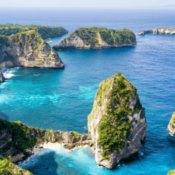
Discover Bali: Facts, Climate, Population, and Geography

Bali, the “Island of the Gods,” is a mesmerizing Indonesian province that beckons millions of travelers annually. Renowned for its rich tapestry of Balinese culture, breathtaking landscapes, and a vibrant tourism scene, Bali offers a unique blend of natural wonders and spiritual depth. From the iconic rice terraces of Ubud to the dramatic volcanic peaks of Mount Agung and Mount Batur, and the sun-kissed beaches of Kuta and Seminyak, Bali promises an unforgettable experience. This in-depth travel guide will equip you with essential information about Bali’s geography, climate, demographics, and must-see attractions.
Essential Information About Bali:
1. Where is Bali?
Bali is situated at the westernmost end of the Lesser Sunda Islands, nestled within the vast Indonesian archipelago. Its geographic coordinates place it around 8.3405° S latitude and 115.0919° E longitude. The Island of Bali lies strategically between Java to the west, separated by the Bali Strait, and Lombok to the east, divided by the Lombok Strait.
Proximity to Other Islands
Bali’s location makes it a perfect starting point to explore nearby islands. Java, Indonesia’s most populous island, is a quick trip across the Bali Strait, while a fast boat or ferry ride will take you to the serene beaches of Lombok.
Island Size and Topography
Despite its relatively small area of about 5,780 square kilometers (2,230 square miles), Bali’s topography is amazingly diverse. From the lush rice paddies of Ubud, often featured in stunning photos, to the rugged slopes of active volcanoes like Mount Agung and Mount Batur, and the picturesque coastal areas, Bali offers a sensory feast of natural beauty. The central mountain range, fertile volcanic soil, and vibrant ecosystem define the island’s unique charm.
Climate
Bali boasts a tropical climate with distinct wet and dry seasons. The wet season, spanning from November to April, is characterized by heavy rains, while the dry season from May to October is sunnier and drier. Year-round temperatures remain comfortable, fluctuating between 25°C and 30°C (77°F to 86°F), making it a year-round travel destination.
2. Population and Demographics
Current Population
Bali has a population of approximately 4.5 million people, with the majority living in the southern part of the island. The island has experienced significant population growth, particularly due to the boom in tourism, which has contributed to the development of urban areas, especially around Denpasar, the capital city.
Major Cities
- Denpasar: As the capital and largest city, Denpasar is the heart of Bali’s economic and administrative activities. Ngurah Rai International Airport (DPS), Bali’s main international gateway, is located here, alongside historical and cultural sites that offer a glimpse into Bali’s past.
- Ubud: Celebrated as Bali’s cultural epicenter, Ubud is known for its traditional arts scene, serene yoga retreats, and breathtaking rice paddies. It’s a popular spot for those seeking tranquility and immersion in Balinese traditions.
- Kuta: This renowned tourist hub is famous for its lively beaches, vibrant shopping, and buzzing nightlife, particularly favored by surfers and young travelers.
Ethnic and Cultural Makeup
Balinese people are the main inhabitants of the island, primarily practicing Balinese Hinduism. This unique blend of Hinduism with animist and Buddhist influences, shapes Bali’s art, spirituality, and traditions. The island is famous for its elaborate ceremonies, rituals, and festivals, which are intricately woven into daily Balinese life.
3. Bali’s Geography & Maps

Bali is divided into eight regencies (kabupaten) and one city (Denpasar), which together form the province of Bali. These regencies include Badung, Bangli, Buleleng, Gianyar, Jembrana, Karangasem, Klungkung, and Tabanan.
Notable Areas
- South Bali: Home to the popular tourist spots like Kuta, Seminyak, Nusa Dua, and Jimbaran, this area offers luxury resorts, vibrant nightlife, and stunning beaches.
- North Bali: A haven of tranquility with less tourist development, North Bali features black sand beaches and peaceful settings, such as Lovina.
- East Bali: Discover authentic Balinese culture in East Bali, where the sacred Mount Agung is located, along with traditional villages like Tenganan.
- West Bali: Less explored by tourists, West Bali boasts national parks, pristine beaches, and rich biodiversity, offering a glimpse into Bali’s untouched natural beauty.
4. Airports and Transportation
Ngurah Rai International Airport
Bali’s primary gateway for international travel, Ngurah Rai International Airport (DPS) is in the southern part of the island, near Kuta. Being the third busiest airport in Indonesia, it offers many facilities, including duty-free shops, lounges, and convenient transportation services.
Other Transport Options
While Bali lacks a comprehensive public transportation system, taxis, private cars, and motorbike rentals are readily available. Ride-sharing apps such as Gojek and Grab are also popular, offering flexibility and convenience for getting around Bali.
Public Transportation
Bali lacks a well-developed public transportation system, but taxis, private cars, and motorbike rentals are widely available. Ridesharing apps like Gojek and Grab are also popular for getting around Bali.
5. Cultural Heritage and Religion
Balinese Hinduism
Balinese Hinduism, a unique fusion of Hindu beliefs with local animistic and Buddhist influences, is central to Bali’s culture. It profoundly impacts art, architecture, festivals, and daily practices. Temples are a common sight, and most Balinese homes feature a small family temple for daily worship.

Sacred Sites and Temples
Bali is adorned with countless sacred temples, such as Tanah Lot, perched dramatically on a rock by the sea, and Besakih Temple, Bali’s largest and most sacred temple complex on Mount Agung’s slopes. Other notable temples are Uluwatu Temple, renowned for its cliffside location, and Tirta Empul, famed for its holy spring water.
Festivals and Ceremonies
Bali’s calendar is bursting with vibrant festivals and ceremonies, including Nyepi, the Balinese Day of Silence, and Galungan, a celebration of good triumphing over evil. These events are deeply spiritual and offer insights into Bali’s rich cultural traditions.
6. Popular Attractions and Activities
Beaches and Coastal Areas

Bali’s coastline is famous for its beautiful beaches, such as Kuta Beach, known for its surf-friendly waves and lively atmosphere; Jimbaran Bay, with its seafood restaurants and tranquil waters; and Seminyak Beach, popular for its luxury resorts and beach clubs. Bali’s beaches cater to various preferences, from vibrant party destinations to peaceful retreats.
Mountains and Volcanoes
Several active volcanoes like Mount Agung, Bali’s highest point, and Mount Batur, famous for sunrise treks, dominate Bali’s landscape. Hiking up these volcanoes provides breathtaking views of the island.
Cultural and Natural Attractions

Bali is a haven for nature and culture enthusiasts. The Sacred Monkey Forest Sanctuary in Ubud is a must-see for animal lovers, while the stunning Tegallalang Rice Terraces offer a look into Bali’s agricultural heritage. The island boasts diverse wildlife in its jungles and along its coasts.
7. Cuisine and Dining
Traditional Dishes
Bali’s cuisine is a delightful mix of local ingredients and foreign influences. Popular dishes include Nasi Goreng (fried rice), Sate Lilit (grilled minced meat satay), and Lawar (a traditional vegetable and meat dish). Fresh seafood, tropical fruits, and spices add unique flavors to Balinese food.
Dining Experiences
From street food stalls (warungs) to high-end restaurants, Bali caters to all dining preferences. Enjoy local dishes at warungs or indulge in gourmet meals at luxury resorts and beachside restaurants.
8. Safety and Health in Bali
Travel Safety
Bali is generally safe for tourists; however, common sense precautions are advised. Avoid poorly lit areas at night and secure your valuables. Bali’s infrastructure has improved significantly in recent years, making it more accessible and safer for visitors.
Health Precautions
Travelers should avoid tap water and be cautious with street food. Travel insurance and pre-trip vaccinations are recommended.
Bali is a magical island that offers an endless array of experiences, whether you’re seeking adventure, relaxation, or cultural immersion. With its stunning natural beauty, rich heritage, and welcoming atmosphere, Bali continues to captivate travelers from around the world. By understanding its geography, demographics, culture, and more, you can make the most of your visit and fully appreciate all that this incredible island has to offer.



